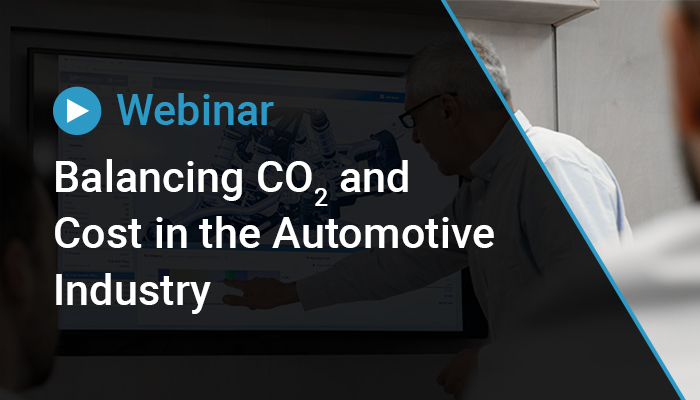5 Sustainable Design Engineering Takeaways from the Manufacturing Insights Conference
It’s common knowledge. A product’s early design determines 80% of its environmental impact throughout the lifecycle.
Presenters at our 2022 Manufacturing Insights Conference underscored the importance of applying early product design feedback to improve manufacturability, profitability, and sustainability. The latter was a hot topic at our conference. Here are five sustainable design engineering takeaways from the conference:
1. Sustainable design engineering doesn’t have to be cost-prohibitive. Manufacturing insights help identify and reduce cost outliers. While it may be an investment upfront, lowering your company’s carbon footprints will save money in the long run – and support the environment. Implementing design for sustainability with aPriori lowers CO2e and costs.
Here’s how it works: Load the 3D CAD into aPriori’s manufacturing insights solution. Then select the digital factory. In a matter of minutes, the design engineer will receive an automated analysis, complete with actionable insights to lower the carbon footprint AND save money. These insights enable manufacturers to:
- Compare price vs. carbon trade-offs.
- Assess new part trade-offs (shape, weight, material).
- Minimize waste.
- Identify reuse opportunities.
The savings over time can be substantial. It is further proof that sustainability is possible without sacrificing profit.
2. Sustainability initiatives can fully succeed. It starts with good design. It’s everywhere and appears to be an insurmountable task: moving to a sustainable practice. It is no longer enough to intend to become sustainable. Customers and governments are demanding true sustainability from businesses.
Bain & Company revealed that just 12% of all corporate change efforts fully succeed. From a sustainability initiative standpoint, the statistics are more disheartening with just 4% succeeding. Despite obstacles, it is imperative that manufacturers become sustainable.
The World Economic Forum noted that 54% of the world’s energy consumption and 20% of its global emissions come from the manufacturing industry. Although many organizations are defining sustainability strategies, just 40% believe they have the knowledge and capabilities to achieve them. Our conference theme underscored that sustainability and profitability are possible and that we do have the knowledge and capabilities. It starts with good design and the right manufacturing insights solution:
- aPriori’s digital factories enable manufacturers to efficiently measure, reduce, and report their products’ manufacturing CO2
- We are continuing to develop and deliver sustainable solutions that allow manufacturers to not only calculate their environmental impact but its cost at the same time.
- Our solutions help manufacturers streamline and enhance the product design and development process for better manufacturability, impactful sustainability, and greater profitability.
Operating sustainably is also good for business. Companies with high ESG performance have operating margins on average 3.7 times higher than those with lower ratings, as well as annual returns 2.6 times higher, according to Accenture’s research. Recently, Forrester recognized our achievements in this area, noting that over the first three years of a customer’s deployment of our solution they gain: 603% ROI in less than 6 months as well as $19.7 million in net present value (NPV).
3. A holistic approach to sustainability is essential. A manufacturing insights solution can get you there faster. The sum of its parts is greater than the whole. By providing insights into manufacturability, sustainability, and cost early in the design process, manufacturers can create a product from a more proactive, interconnected, and collaborative perspective. The skills and methodologies of designers from multiple disciplines enhance this process.
It is at this juncture that manufacturing insights prove to be a powerful and holistic sustainability tool. For instance, early feedback might indicate that making a certain part requires many steps that increase material and energy usage, which raises carbon emissions. Perhaps, a part can be redesigned to avoid relying on a more expensive material supplier that is geographically remote to reduce both costs and the carbon footprint. Manufacturing insights support holistic design by:
- Considering the life of a product and analyzing how design decisions will impact sustainability, manufacturability, product performance, and cost.
- Allowing for more design iterations via a faster, more efficient, and more accurate evaluation of the feasibility of each.
- Incorporating expert feedback from all critical areas (cost, sourcing, production, etc.) early in the process to avoid late-stage redesigns.
A holistic approach to design, fostering greater collaboration and better data analysis through a single truth source, ensures a more sustainable product, faster time to market, and downstream success.
4. Materials are the main contributor to total CO2e emissions. Sustainability insights can reduce the carbon footprint. Approximately 23% of greenhouse gases come from industrial emissions.
Manufacturing insights can play a pivotal role in reducing material usage by:
- Providing analysis of processes and recommendations to determine the most efficient use of materials (buy-to-fly ratio).
- Examining materials to surmise if the shape or thickness of a part is being influenced by the material and providing alternatives.
- Weighing the advantages of using higher cost, higher performance, and higher CO2e materials, which might provide lower overall cost and CO2e down the road.
- Determining if there is a more sustainable material supplier closer to the manufacturer.
Materials are just part of the equation. Essential to reducing the carbon footprint is changing how you manufacture. Manufacturing insights support that effort.
5. The key to success is to move from intent to impact. aPriori is your ally. Manufacturers are dealing with many challenges. Supply chain issues persist. Many continue to experience labor shortages and skills gaps. Inflation woes linger in the background. And if those challenges weren’t enough, manufacturers grapple with how best to ensure the manufacturability of high-value products while also meeting sustainability initiatives and profitability goals.
What’s more, it’s not enough to intend to address these issues and goals. There must be a measurable impact. We like to encourage manufacturers to “move from intent to impact.”
During our conference, talk of sustainability enlivened our sessions and even our breaks. And although it is at the forefront of many manufacturers’ initiatives (and rightly so), the two constants have always been manufacturability and cost. What’s more, these discussions weren’t siloed by design engineers, cost engineers, sourcing, executives, etc. Instead, they were open and collaborative discourses on where manufacturing is and where it’s headed.
Therein lies the beauty of our manufacturing insights. They encompass all personas and objectives. It takes the best of information sharing, collaboration, discussion, and innovation, combining them into a powerhouse for your organization. We harness your intent and turn it into impact.
If you couldn’t attend this year’s event, be on the lookout for news on our 2023 conference. Each year, it is bigger and better than ever, with new product launches, industry leader presentations, case studies, workshops, and of course, some good fun mixed in.
Need to Balance CO2 and Cost Requirements?
See how manufacturers are reducing their carbon footprint while maintaining their margins.








